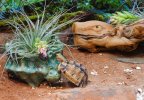Martha Lisa Garcia (Dovelett15) was generous enough to let me purchase these healthy and curious cuties from her. Luckily we are both in California as they can not be sold over state lines. I have three that are four months old and two that are eight months old. I had read that the Egyptians can be shy but these little diamonds are active from the time they wake up, and have their morning soak until early afternoon. I am fortunate to have a Smart Enclosure, closed chamber, from Markw84, Mark Wilson, so my heat, lights and humidity are pretty easy to get right. I love how active and curious they are.
Claudia in California


Claudia in California


